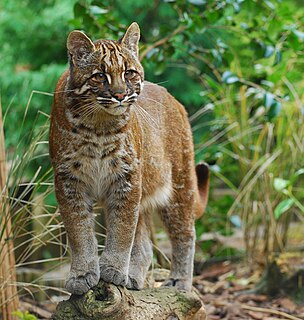
The Asian golden cat is a medium-sized wild cat native to the northeastern Indian subcontinent, Southeast Asia, and southern China. It has been listed as Near Threatened on the IUCN Red List since 2008, and is threatened by hunting pressure and habitat loss, since Southeast Asian forests are undergoing the world's fastest regional deforestation.

Mizoram is a state in northeastern India, with Aizawl as its seat of government and capital city. The name of the state is derived from "Mizo", the self described name of the native inhabitants, and "Ram", which in the Mizo language means "land." Thus "Mizo-ram" means "land of the Mizos". Within India's northeast old-Assam region, it is the southernmost landlocked state, sharing borders with three of the Seven Sister States of old Assam, namely Tripura, Assam and Manipur. The state also shares a 722-kilometre border with the neighbouring countries of Bangladesh and Myanmar.

The red garra, also known as the doctor fish or nibble fish, is a species of cyprinid that is native to a wide range of freshwater habitats in subtropical parts of Western Asia. This small fish typically is up to about 14 cm (5.5 in) in total length, but locally individuals can reach as much as 24 cm (9.5 in).

The Nilgiri Biosphere Reserve is an International Biosphere Reserve in the Western Ghats and Nilgiri Hills ranges of South India. The Nilgiri Sub-Cluster is a part of the Western Ghats, which was declared a World Heritage Site by UNESCO in 2012. It is the largest protected forest area in India, spreading across Tamil Nadu, Karnataka and Kerala. It includes the Aralam, Mudumalai, Mukurthi, Nagarhole, Bandipur and Silent Valley national parks, as well as the Wayanad, Karimpuzha, and Sathyamangalam wildlife sanctuaries.
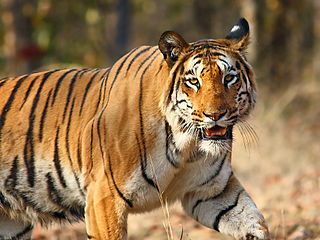
The Indian government has established 18 biosphere reserves to protect larger areas of natural habitat than a typical national park or animal sanctuary, and that often include one or more national parks or preserves, along with buffer zones that are open to some economic uses. Protection is granted not only to the flora and fauna of the protected region, but also to the human communities who inhabit these regions, and their ways of life.

Periyar National Park and Wildlife Sanctuary (PNP) is a protected area located in the districts of Idukki and Pathanamthitta in Kerala, India. It is notable as an elephant reserve and a tiger reserve. The protected area encompasses 925 km2 (357 sq mi) of which 305 km2 (118 sq mi) of the core zone was declared as the Periyar National Park in 1982. The park is a repository of rare, endemic and endangered flora and fauna and forms the major watershed of two important rivers of Kerala, the Periyar and the Pamba.
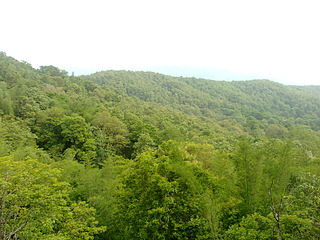
Parambikulam Tiger Reserve, which also includes the erstwhile Parambikulam Wildlife Sanctuary, is a 391 square kilometres (151.0 sq mi) protected area in Kollengode Block, Chittur taluk in Palakkad district of Kerala state, South India. The wildlife sanctuary, which had an area of 285 square kilometres (110 sq mi) was established in 1973. It is in the Sungam range of hills between the Anaimalai Hills and Nelliampathy Hills. Parambikulam Wildlife Sanctuary was declared as part of the Parambikulam Tiger Reserve on 19 February 2010. Including the buffer zone, the tiger reserve has a span of 643.66 km2. The Western Ghats, Anamalai Sub-Cluster, including all of Parambikulam Wildlife Sanctuary, is under consideration by the UNESCO World Heritage Committee for selection as a World Heritage Site. The sanctuary is the home of four different tribes of indigenous peoples including the Kadar, Malasar, Muduvar and Mala Malasar settled in six colonies. Parambikulam Tiger Reserve implements the Participatory Forest Management Scheme (PFMS). People from tribal colonies inside the reserve are engaged as guides for treks and safaris, and are provided employment through various eco-tourism initiatives. The tiger reserve hosts many capacity building training programmes conducted by Parambikulam Tiger Conservation Foundation in association with various organisations.

Dampa Tiger Reserve or Dampha Tiger Reserve is a tiger reserve of western Mizoram, India. It covers an area of about 500 km2 (190 sq mi) in the Lushai Hills at an altitude range of 800–1,100 m (2,600–3,600 ft). It was declared a tiger reserve in 1994 and is part of Project Tiger.

Garra is a genus of fish in the family Cyprinidae. These fish are one example of the "log suckers", sucker-mouthed barbs and other cyprinids commonly kept in aquaria to keep down algae. The doctor fish of Anatolia and the Middle East belongs in this genus. The majority of the more than 140 species of garras are native to Asia, but about one-fifth of the species are from Africa.

Mamit district is one of the eleven districts of Mizoram state in India. Mamit is located at the western part of Mizoram. It shares an international border with Bangladesh, divided by the Sajek river. Mamit district has a very significance in term of National security due to border district. Dampa forest and Dampa tiger reserve, the most important location in Mazoram fall under Mamit district.
Bufoides meghalayanus is a species of toad in the family Bufonidae, the true toads. It is also known as the Mawblang toad, rock toad, or Khasi Hills toad. It is endemic to northeastern India where it is known from Meghalaya and Mizoram. However, records from Mizoram may represent an undescribed species, and this species might have a very restricted range in the Khasi Hills near Cherrapunji.

Garra gotyla is a species of ray-finned fish in the cyprinid family from freshwater in South Asia.
Garra kempi, the Kemp garra, is a species of ray-finned fish in the genus Garra from the Indian states of Arunachal Pradesh, Manipur, Meghalaya, Mizoram and Nagaland.

The mullya garra or sucker fish is a species of ray-finned fish in the genus Garra. It is found in streams and rivers throughout India except for Assam and the Himalayas. Reports of the species from Nepal have not been verified.
Mizoram is one of the fastest growing economies among the states of India with a per capital income of Rs 50,021. Mizoram had the second highest GSDP growth during the 11th Five Year Plan (2007–2012) in Northeast India at 11% exceeding the target of 7.8% which is also much higher than the national average of 7.9%. During the 10th Five Year Plan (2002–2007), the Gross State Domestic Product (GSDP) was expected to grow at around 5.3% but grew at 5.7%. The biggest contributors to GSDP growth are agriculture, public administration and construction work. Tertiary sector of service sector continued to have the contribution to the GSDP with its share hovering between 58% and 60% during the past half a decade.
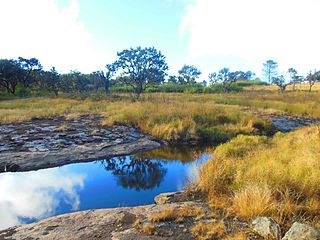
Phawngpui National Park or Phawngpui Blue Mountain National Park is one of the two national parks of India in Mizoram, the other and the larger being Murlen National Park. It is about 300 km from the main city Aizawl, located in the Lawngtlai district, towards the southeast of Mizoram and relatively close to Burma. It bears the name of the mountain Phawngpui, often called the Blue Mountain of Mizoram, which is the highest mountain peak in the state, reaching 2,157 m asl. The national park covers the entire mountain along with the surrounding reserve forest.
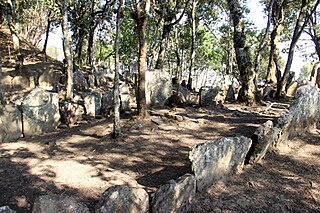
Mizoram is a state in the northeast of India. Mizoram is considered by many as a beautiful place due to its dramatic landscape and pleasant climate. There have been many attempts to increase revenue through tourism but many potential tourists find the lack of amenities to be a hurdle. However, the State continues to promote itself and many projects have been initiated. The tourism ministry continues to maintain or upgrade its tourist lodges throughout the state. Foreign tourists are required to obtain an 'inner line permit' under the special permit before visiting. The permit can be obtained from Indian missions abroad for a limited number of days or direct from Mizoram Government authorities within India. The state is rich in bird diversity, which has the potentiality to make it a major birding destination. For Mrs Hume's pheasant, Mizoram is a stronghold. There is also a rare record of the wild water buffalo from the state. There are several past records of the Sumatran rhinoceros from Mizoram, then Lushai Hills. The small population of wild elephants can be seen in Ngengpui and Dampa Sanctuaries. Some of the interesting sites are Mizo Poets' Square also known as Mizo Hlakungpui Mual in Mizo, the Great Megaliths locally known as 'Kawtchhuah Ropui'.
Garra elongata is a species of ray-finned fish in the genus Garra from Manipur in north eastern India and possibly Myanamar.

The following outline is provided as an overview of and topical guide to Mizoram:

Dampa Legislative Assembly constituency is one of the 40 Legislative Assembly constituencies of Mizoram state in India.














